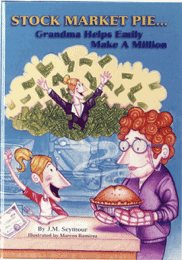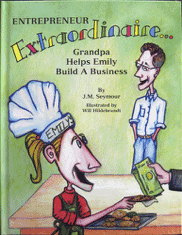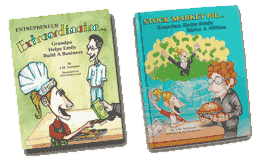Editors and Producers:
We are happy to provide information, interviews and review copies of our materials. Please use the "contact us" button or call us at 515-991-3990.
Publicity Releases:
You have the publisher's permission to use the following articles, provided that customary attribution is given. We also appreciate reference to www.moneygodmother.com.
Our authors and topical experts are always interested in working with the media. To arrange interviews, please contact: chuck@dynamindspublishing.com or 515-991-3990. High-resolution photos are available upon request.

IMMEDIATE RELEASE
Kids Learn Business Moxie
Des Moines, IA —This fall, Nick begins 8th grade with a bank account flush from his summer lawn mowing clients. The 13-year-old entrepreneur cut his business teeth early, thanks to his grandfather’s clever tutelage. Nick mastered customer service, pricing, time management, and marketing, boosting him beyond ordinary classroom skills and whetting his appetite for entrepreneurship. Besides, he had fun.
“When kids show interest in running a business—even if it’s a weekend lemonade stand— parents and teachers should encourage that spark. Those exposed to entrepreneurship early are more likely to start their own businesses…and more likely to succeed,” says author, financial educator and entrepreneur J.M. Seymour.
“Entrepreneurship at any age is hard work, but what better way for a young person to see what it takes? It’s an experience that affords valuable lessons and builds lifetime skills that we need in today’s workplace.”
Entrepreneur Extraordinaire, Seymour’s newest children’s book, tells the story of how Emily plans to build her cookie business. Both her mom and grandpa recognize entrepreneurial interests and turn Emily’s idea into a lesson. Colorful illustrations and clever sidebars guide readers through basic business steps, including how to sell, devise a business plan, start a company, price product, market, and package.
Seymour’s educational books, including the award-winning Stock Market Pie, and free mentoring tips for parents and teachers can be viewed at www.DynaMindsPublishing.com.

For Immediate Release
Tips for Budding Entrepreneurs
The basic plot of Entrepreneur Extraordinaire was designed to appeal to sixth grade readers. Plus the sidebar resources and business advice are timely for beginning entrepreneurs, regardless of age, acknowledges Seymour, who lists five helpful tips to encourage budding business owners:
1) Get going.
There are dozens of businesses youth can start (many will get them off the couch). Consider walking dogs, growing vegetables to sell, mowing lawns, weeding, repairing bicycles, and becoming a birthday party clown or mother’s helper.
2) Think big; Start small.
Exploring potential is part of business planning, so let ideas flow freely and set goals. Be careful to point out realistic start-up needs for time and money. Remember, learning is as important as making money.
3) Find mentors.
Entrepreneurs often discover mentors among parents, family friends or relatives who run businesses. Help kids connect with local business owners you know. Make it a fun adventure.
4) Talk ‘em up.
Kids, like most of us, thrive on encouragement. Recognize their successes, perhaps even give a “hard work bonus” as a reward. You can build a budding entrepreneur’s confidence, self-esteem, and ability to succeed.
5) Everyone stumbles.
Though it’s not easy to watch, failure usually precedes success. It’s okay to make mistakes. Entrepreneurs develop resilience, tenacity, ability to evaluate risk, and a solid work ethic.
-30-
Media kits, review copies, interviews and feature story material available on request.
Contact Chuck Kuster 515-2991-3990.

For Immediate Release
Stock Market Pie: Grandma Helps Emily Make A Million
The story of Stock Market Pie begins when Emily receives a stock certificate as a present from her grandmother. At first, Emily thinks Grandma’s gift is no big deal. As the two bake apple pies, Emily learns about the stock market and investing. “The stock market is like a pie. Everyone can own a piece,” Emily says, showing a new appreciation for Grandma’s extraordinary gift of wealth.
Stock Market Pie is an entertaining story with colorful illustrations and educational sidebars. This award-winning book includes explanations of key investment concepts like “bull” and “bear” markets, plus a glossary. It’s suitable for any beginning investor, age 9 to 90.
Makes a great gift!
“What a great investment for parents, grandparents, teachers, and brokers looking to help young people understand the stock market and start their own investment portfolio. Stock Market Pie…can help any beginning investors get started. It’s easy to understand, fun to read…a delightfully palatable lesson.”
Reviewer: Louis M. Thompson, Jr., President & CEO, National Investor Relations Institute
“Don’t be deceived by what looks like a picture book. Stock Market Pie is a good primer for middle schoolers.”
Reviewer: Kiplinger’s Magazine
-30-

For Immediate Release
Grandparents Can Boost Financial Literacy
By J.M. Seymour
Grandparents with investment smarts can discover a wealth of simple opportunities to get to know their grandkids as well as teach financial savvy that lasts a lifetime. The sooner you start, the better.
Here are a few ideas to help turn spenders into savers:
+ Make birthday gifts of "investment" money instead of spending money. (This could work for allowances too.) Discuss ways to invest the gift.
+ Read fun books about investing. A good place to start is Stock Market Pie: Grandma Helps Emily Make A Million, which uses a simple analogy to tell a lighthearted story about stock market investing and is appropriate for beginning investors as young as eight. For more information, go to www.dynamindspublishing.com or 1/888-991-Book.
+ Take grandkids to visit a stockbroker's office or a stock exchange. Pick up literature, ask questions, watch the market's activity via computer.
+ Pick a stock of interest to study together. Find an annual report or web site, visit or call the company, sample the products, and decide on a reasonable purchase price. Invest with real or imaginary money. Consider kid-friendly products--soft drinks, restaurants, clothing brands, cosmetics, software, toys.
+ If you actually buy stock for a gift, send the stock certificate to your grandchild.
+ Start a DRIP account, or Dividend Reinvestment Program. After an initial stock purchase, some companies allow you to reinvest dividends and buy more stock periodically. Other companies allow direct stock purchases. Web sites such as www.sharebuilder.com also offer low-cost purchase options.
+ Attend the annual stockholder's meeting of a local company with your grandchild.
+ Log onto entertaining websites on investing. Some good ones are:
http://www.moneyopolis.com
http://www.younginvestor.com
http://www.treas.gov/kids/index.html
+ Play a stock market game. Find an on-line game at http://www.smg2000.org or www.wallstreetsurvivor.com
+ Start an imaginary portfolio of several stocks and keep track by charting results for a period of time. The investor with the best performing portfolio wins.
+ Develop a simple graph--it might be recent stock prices, yearly sales, or P/E ratios for a particular industry, such as restaurants or soft drink companies.
+ Play detective and find new start-up companies (or industries) that would make good stock picks. Use the internet, visit shopping malls, discover new products.
Learning to invest doesn't require any fancy equipment, uniform, special shoes, or a lot of money. Teaching the skills that could help your grandkids become rich is not an expensive proposition...but failing to teach them is.
-30-

For Immediate Release
Why Johnny Can't Save
by J.M. Seymour
Another crisis plagues American schools and families. It deals with financial illiteracy, or why Johnny and Jane can't save.
That's not to say Johnny and Jane are ignorant about money or haven't any at their disposal. Actually, an American teenager spends an average of more than $105 per week--that's more pocket change than any other generation of teens, according to Teenage Research Unlimited.
Yet, statistics show we are raising financially illiterate kids, with the sobering results being more consumer debt, lower saving rates, and lost opportunities for retirement wealth. How can today's hardworking parents not be imparting sound money management skills? Knowing how to save and spend was learned almost naturally by these baby boomers themselves, who typically grew up under their parents' philosophy of "work, save, buy when you accumulate the money."
Managing personal finances was relatively simple then: A typical family used the local bank for a savings account, checking account, mortgage, and perhaps a car loan. Most customers paid cash for purchases, but some may have used store layaways to afford special items. No one got a credit card without steady income and a permanent address. (Besides, those who bought on credit were not admired.) High school graduates could balance a checkbook, figure percentages, and count change when making a purchase.
But today, most teenagers would fail a basic test on money management, even though parents think their kids are financially savvy. This is documented by a personal financial survey conducted every two years by Jump$tart Coalition for Personal Financial Literacy, a national consortium helping to educate young Americans on money matters.
What has happened? More and more options to use money have bombarded all of us. As a result of this growing financial smorgasbord, many young consumers don't know whether--or how--to spend, save, invest, or borrow money. Sadly, parents and schools aren't taking time to teach money management skills, so most teenagers receive little or no training to develop wise habits. Add this to the fact that we now live in a "gotta-have-it-today" society, and the picture becomes even bleaker.
Saving and investing have taken a back seat to instant gratification. In fact, the savings rate of Americans has been at an all-time low of less than two percent. More than half of American households live from paycheck to paycheck, according to the Federal Reserve. How unfortunate, since the present generation includes the beneficiaries of one of America's wealthiest eras. This spending generation stands to inherit a large nest egg, but not have the skills to save and invest wisely to perpetuate their fortune for the next generation.
How can we change this scenario so that saving and investing skills are taught to kids? Four adult groups can play a role in boosting financial literacy with a few simple efforts--parents, teachers, investment professionals, and librarians.
#1 We must turn spenders into savers.
Once kids get beyond the "gotta-have-it-now" syndrome, saving and investing can be fun. Saving and investing to buy larger purchases can also be rewarding. Parents can model a saving/investing mentality. Teachers can develop related activities, such as learning how the stock market works. Librarians might want to build a summer or after-school program around an investing theme. Invite a stockbroker or banker to read. Start an investment club, or let kids create a stock portfolio with imaginary money.
#2 Invest in learning to invest.
Let's teach kids not only to save money, but how to use it as a tool to make more money. Developing kids' money management skills can lead to more productive citizens, and in turn, more economically stable families and communities. Nearly everyone can play a part in raising financial literate kids. Books like Stock Market Pie--Grandma Helps Emily Make A Million from DynaMinds Publishing is a great starting point for teaching the basics of investing in a fun way. Check the local library or www.DynaMindsPublishing.com for other resources.
#3 Help kids practice what they learn--and start young.
Exciting things can happen when you turn a saver into an investor. But, like learning to read, to play piano, or to throw a baseball, it takes practice to become a proficient investor. All too often, kids--and adults--want the rewards without the effort. But let's put the value of financial skills into proper perspective. Would you expect your child to flourish in school without knowing how to read well? Would you expect your child to be a successful soccer player if he/she didn't know the rules or have proper shoes and gear?
Parents typically spend thousands of dollars building children's skills for music, athletics, dance, and other activities. Learning to invest doesn't require fancy equipment, uniform, special shoes, or a lot of money. Teaching the skills that could help your kids become wealthy is not an expensive proposition...but failing to teach them is.
-30-

For Immediate Release
Make Saving, Investing Fun for Young Spenders
by J.M. Seymour
What parents don't want to convert a youthful spender into a saver and wise investor? Most would love to see their children be money savvy. "But we just don't have the time or easy resources at hand," says J.M. Seymour, author of investing books and other tools that help children learn about money.
Time-weary parents don't need to be financial wizards or study dozens of books before they can succeed in teaching children how to save and invest. Learning to save, spend, borrow and invest is no different than learning to play the piano, throw a baseball or be polite. "We perfect skills a little at a time and we learn from modeling behavior we see, whether the teaching is planned or unplanned. So, even if you do nothing, your children will pick up on your habits," says Seymour.
To actively teach saving and investing, parents just need to focus on two things: start early and make it fun.
Seymour advocates these two simple keys to success, no matter how old children are. The learning can start when kids can grasp the idea of spending money to get what they want--usually as young as three or four. Begin by using teachable moments to ward off spendthrift behavior--during trips to the store, dinner table talk about buying Christmas presents, or when vacations are planned.
Show them that spending money means setting priorities, not having everything. Seymour points to an example of one family who works together to save money for vacations. "Before they buy pizza or see a movie, everyone votes whether the entertainment money might be better invested in the upcoming vacation fund. What a great way to involve kids in the decision making and goal setting."
Next, focus on learning about investment tools, such as buying stocks, to meet their goals, Seymour adds. "Introduce lessons with products they know. Food is good. Even a 10-year-old likes to imagine that all the customers lined up to buy hamburgers at his favorite fast-food chain are putting money in his pocket--if he owns the stock. Our daughter got started with a stock of a local convenience store because she always wanted the donuts."
Even grandparents who live several hours away can get involved in teaching grandchildren good investing skills. "If giving the cursory Christmas or birthday money leaves you feeling empty or unappreciated, try new tactics that focus on investing rather than spending. You'll teach lifelong lessons at the same time," advises Seymour, whose book Stock Market Pie... Grandma Helps Emily Make A Million, has helped many grandparents launch young investors. For more ways to teach investing skills, see www.dynamindspublishing.com .
-30-

For Immediate Release
Stock Market Pie Wins "Outstanding Book" Award
Johnston, IA -- Stock Market Pie...Grandma Helps Emily Make A Million won a merit award for excellence in the Midwest Independent Publishers Association annual competition. The unique children's book was published by DynaMinds® Publishing and was the only Iowa published title to receive an award.
Stock Market Pie won its award in the popular "how-to" category. "Given the competition, it was an honor to have Stock Market Pie receive such recognition," says J.M. Seymour, author and Johnston, Iowa resident. Seymour wrote the book to help parents and grandparents teach children how to save and invest money.
-30-








